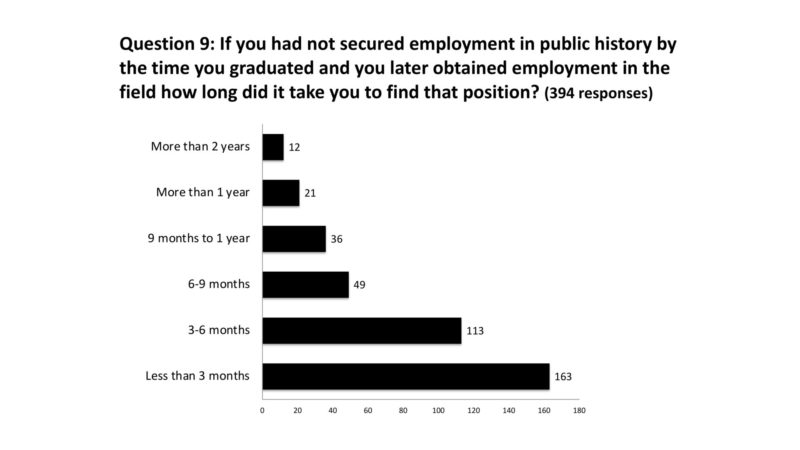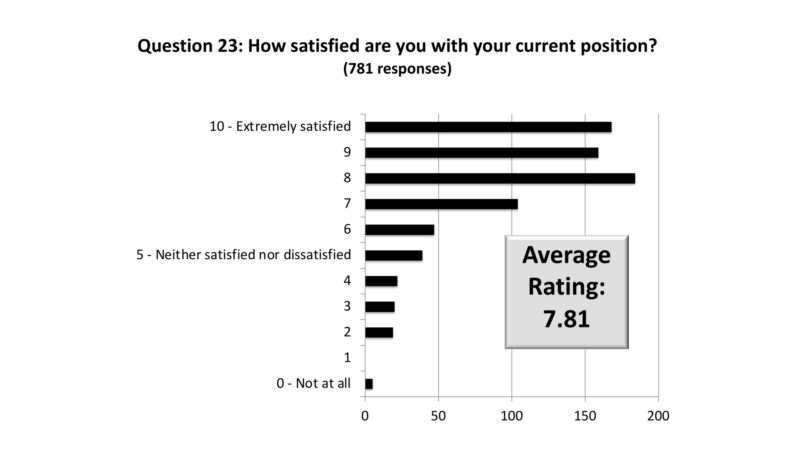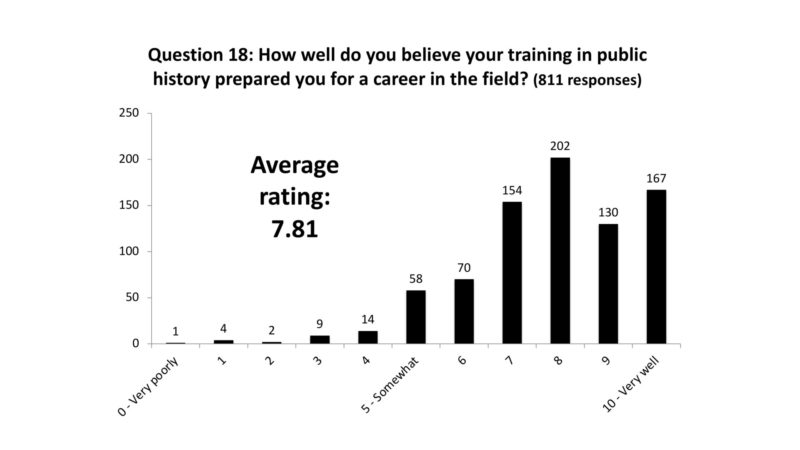Surveying public history careers
15 September 2020 – Daniel Vivian
Editors’ Note: This is the second of five posts summarizing the findings of the Joint Task Force on Public History Education and Employment, an initiative launched in 2014 to study trends in public history education and employment.
The second major project undertaken by the task force, a survey of alumni of master’s-level programs in public history and closely related fields, sought to understand the career paths of public historians. The primary goal of the survey was to understand how the 2008 crash had affected recent recipients of M.A.s in public history, but the task force believed it important to develop a broad perspective on questions about time between graduation and employment, advancement, and job satisfaction. Therefore, the survey sought to capture the experiences of people who had received master’s degrees in public history and closely-related fields as far back as the mid-1980s in an attempt to create a general portrait of careers in public history during the past three decades.[1]
It is important to note that the alumni survey was completed well before the advent of the COVID-19 pandemic. All of the data collected and the comments provided by respondents, therefore, refer to the pre-pandemic era. Already, the pandemic has dramatically weakened the public history job market and caused layoffs and furloughs at a number of institutions. Given these developments, the value of the alumni survey now lies mainly in what it shows about public history careers over the long term and how inaccurate many of the assumptions behind the “perfect storm” scenario proved to be. Although the overall health of the public history job market has plummeted, the information about long-term trends and how public historians view their careers and working conditions in the field remains useful—and is the best-available body of information of its kind.
The alumni survey consisted of thirty-three multiple-choice questions and offered respondents the opportunity to provide written comments. The questions covered a wide range of topics, including respondents’ graduate education, employment history, early-career job searches, job satisfaction, and current employment circumstances. Several sought information relating to concerns the task force considered fundamental to its mission:
- Were recent recipients of M.A.s in public history finding jobs? How long was it taking them to find positions, and what sort of positions did they typically accept?
- How long has it generally taken M.A recipients to find employment in the field? Has the interval between receipt of degree and employment changed over time?
- Is there an imbalance between the number of recent graduates of Master’s programs in public history and available jobs in the field?
The task force promoted the survey with announcements posted on the websites of the four sponsoring organizations, social media posts, and announcements at professional meetings. In addition, task force co-chairs Philip Scarpino and Daniel Vivian sent emails to public history educators asking them to encourage alumni of their programs to take the survey.
The task force made the survey available online in April 2016 and continued collecting responses through May 2017. It ultimately received 1,488, a number that exceeded expectations and gave the task force confidence in the general trends shown in the data. Respondents again provided a mixed view of the field. On the one hand, the data from the multiple-choice questions offered a relatively positive view of the job market. Sixty-four percent of respondents reported that the first professional job they obtained after completing their public history degree was in public history.[2] Forty-one percent secured employment within three months of graduating, and twenty-nine percent found employment within three to six months. An overwhelming majority of respondents—91 percent—found employment within a year. The significance of these figures is bolstered by the fact that most survey respondents had received their degrees relatively recently. Almost forty percent had graduated between 2012 and 2016, and 77 percent had graduated since 2005. Put simply, the data shows that graduates found employment in the field relatively quickly in the late 2000s and early 2010s, despite the 2008 financial crisis and its aftermath.

Time between receipt-of-degree and employment based on aggregate responses to the survey of alumni of master’s programs in public history.
The survey data also shows that most graduates found full-time positions, not part-time or term-limited employment. Sixty percent of respondents reported that the first position they took after graduating was full-time. Eighteen percent accepted part-time employment; fourteen percent took full-time temporary positions. A majority of respondents (55 percent) remained in their first public history job for five years or less, and twelve percent stayed for between five and ten years. Most respondents (76 percent) remained in the field after leaving their first position. Further, 60 percent of respondents indicated that they received benefits of some sort in their first public history position.
Most importantly, a large majority of respondents—87 percent—reported that they are currently employed in public history or a closely related field. Most also indicated they are satisfied with their current position. Respondents rated their level of satisfaction on a 0-10 scale, with 0 representing “not at all satisfied,” 5 representing “neither satisfied nor dissatisfied,” and 10 indicating “extremely satisfied.” Responses averaged 7.81, and 80 percent of respondents chose a rating of 7 or better.

Most respondents to the alumni survey reported relatively high levels of satisfaction with their current position. At the same time, respondents’ written comments expressed strong concerns about the future of the field and the ability for young professionals to find positions that are satisfying, offer acceptable working conditions, and provide reasonable salaries and benefits.
Overall, the survey data suggests that early-career professionals had relatively healthy opportunities before the pandemic and that most professionals viewed their working conditions favorably. Comments provided by respondents provide a somewhat different perspective. Of the nearly 1,500 people who took the survey, 682 submitted written remarks. Some described their personal stories and explained how they obtained their first job in the field or found their way into a position suited to their interests and abilities. Others described circumstances that had constrained their job search and discussed the effect on their careers. Still others explained why they had sought employment outside of public history and discussed the utility of their public history training for non-public history positions.

The alumni survey found that most respondents believe their public history training provided them with good preparation for a career in the field.
Many comments emphasized the pressures facing historical organizations and institutions. As with the employer survey, respondents identified declining public support (financial and otherwise), the constant need to raise money, demands imposed by use of digital technologies in interpretive programming and reaching audiences via the Internet, and changing audience tastes as reshaping the labor of public historians. Concerns about the future of the field and the circumstances facing young professionals correlate closely with the sense that conditions have changed in ways that do not favor the basic goals of public history. Many respondents echoed the apprehensions that led to the task force’s founding. Statements about declining job opportunities, overproduction of public historians, and fears that new graduates will be burdened with debt in a field with few opportunities proved common. The gloomiest commentary offered blanket condemnations of the public history job market and working conditions (“there are no jobs,” “salaries are low”), while other respondents provided more circumspect views. Regardless, a strong sense of anxiety about the future of the field is plainly apparent.
Some of the discordance between the survey data and written comments may reflect the survey methodology. It is possible that the survey data overweight favorable outcomes. The task force had no way to create a database that included all graduates of master’s-level public history programs over a given period of time and then survey a random sample of that data set. By announcing the survey through professional organizations and social media and asking public history programs to encourage their alumni to take the survey, it used the best options available. This methodology, however, likely favors people who have developed successful careers in public history or have at least remained involved to the extent that they are engaged with alumni and professional networks. “Success stories” are more likely to appear than those of people who have turned their back on the field.
Still, the 1,488 responses that the survey received cannot be ignored. The size of that number alone provides reasons to be confident in the data and the trends shown. Although some of the numerical ratings may be somewhat higher than they would have been with a more rigorous methodology, the task force believes the basic findings of the survey to be accurate. Indeed, the survey data affirms the reasons some experienced public history educators questioned the “perfect storm” scenario as it developed. They knew that recent graduates of their programs were finding jobs, even as the 2008 crisis struck and job opportunities dwindled.
The task force released a report on the alumni survey, “Career Paths in Public History: A Report,” in 2019. Three appendices present the survey questions, the survey data, and the comments submitted by respondents.
The next post in this series will offer perspectives on several of the questions that inspired the creation of the task force and some of its major findings.
~Daniel Vivian is an associate professor and chair of the Department of Historic Preservation at the University of Kentucky. He has served as co-chair of the Joint Task Force on Public History Education and Employment since 2014.
[1]The survey questionnaire asked respondents to provide the title of their first public history position. These are available as the compiled responses to question 8 (see Appendix B: Survey Data, 15-30).
[2] Most survey respondents hold a M.A. in public history (56 percent) or M.A. in history with some public history training (18 percent). Others have a graduate certificate in public history (3 percent), a dual master’s in public history and another field (7 percent), or started a master’s in public history but did not graduate (1 percent). A final category allowed respondents to specify “other” for their educational background (15 percent). Degrees specified by persons in this group included American studies, museum studies, historical administration, historic preservation, and public humanities.



